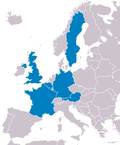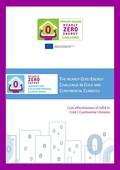nZEB in Cold/Continental climates
TaskForce Overview
Members and Geographical Coverage
Central Europe is in leading position in terms of density of very low energy housing. In Austria, more than 6.000 dwellings in very low energy buildings have been realised within the last 10 years, amongst those are nearly 4.000 dwellings in multi-family buildings. Because of the forerunner status of the region in which it operates, Gbv, the Austrian Federation of Limited Profit Housing Associations representing both cooperatives and capital companies took the lead in the TaskForce in order to share their experience of managing very low energy buildings in Cold/Continental climates.
GdW, the German Federation of Real Estate and Housing Associations, VMSW, the Flemish Agency for Social Housing, SABO, the Swedish Association of Municipal Housing Companies, NHF, the National Housing Federation and USH, the French Federation of Social Housing Providers (considering the interest of its members based in the northern part of France) also joined the TaskForce in order to contribute to the knowledge exchange on very low energy housing technologies with an emphasis on construction and management costs, quality assurance, maintenance issues and monitoring of energy consumption.
Objectives and expected Outcomes
- Identify obstacles and challenges that Housing Organisations are facing in reaching nZEB targets for existing housing stock and new build in Cold/Continental Climates and define a common Work Programme;
- Define nZEB Basics for Cold/Continental Climates: Technical key elements and solutions - Cultural, traditional, climatic and environmental features and specific needs - Legal and financial framework and market penetration;
- Produce Reports on Operating Costs, Usability and Cost Effectiveness and Guidelines and Recommendations for National nZEB 2020 Road Maps on the basis of the analysis of the identified existing low energy buildings in Cold/Continental Climates.
Needs Analysis and Work Programme
Through a survey carried out during the first phase of the project, members of this TaskForce identified key challenges that Housing Organisations are facing in reaching nZEB targets for existing housing stock and new built in Cold/Continental climates. Based on its findings, the Taskforce Coordinator shaped the WorkProgramme and defined the respective calendar of activities (see box on the right) in order to better address the issues at stake.
During the implementation of the WorkProgramme, alongside with exploring synergies and considering recent outcomes and key resources resulting from other running European/National projects, the TaskForce ensured that the knowledge produced had been disseminated to wider target groups, such as decision-makers, building chains stakeholders and financial institutions.
Furthermore, the members of the TaskForce also monitored the current Policy Framework in their respective Member States, bearing in mind that the ultimate goal of the POWER HOUSE nZEC! project was to help them in shaping nZEB definitions and helping Public, Cooperative and Social Housing organisations from all across Europe implementing the new nZEB obligations!
Download here the Taskforce Needs Analysis & Work Programme.
TaskForce key Findings and Conclusions
Attempting to summarise in a few words the results of this extensive work is far too ambitious, however, below are listed some of the key findings and conclusions elaborated by TaskForce Members:
Definition of cost-optimal levels
The cost-optimal level is defined as the “energy performance level which leads to the lowest cost during the estimated economic lifecycle” of a building or building element. The level is determined by taking into account a range of costs such as investments, maintenance, operating costs and energy savings. However, some parameters to calculate cost-optimal levels are not easy to predict such as future primary energy factors, cost development, price trends and performance of new technologies.
A crucial question regarding cost-optimal building standards and the cost-efficiency of nearly-Zero Energy Buildings is whether calculated energy demand and costs assumptions correspond with measured energy consumption and real cost data from buildings when in use. Additionally, there are some competition factors between different technical components of energy efficient buildings: insulation vs. heating and ventilation technologies vs. renewable systems (heat pumps, solar plants, PV); the calibration between these components is challenging and definitely not only subject to expert calculations but also a matter of competition between different stakeholders in the energy services sector including energy providers.
Actual performance vs. calculated demand
The monitoring results from the Austrian test cases (selected out of a bigger sample of housing projects) that took into account construction, energy consumption and service costs showed that the predicted margin in energy demand between low energy buildings and very low energy buildings was bigger than the actual differences in energy consumption for heating and hot water. Therefore, housing energy policies should be based on consumption data rather than on calculated demand, since there is a substantial divergence between these figures.
Cost-effectiveness in new housing projects
In new, very low energy buildings and passive houses, extra construction costs for additional/extra insulation and ventilation with heat exchange total 6.7% for small buildings and 9.7% for large (compact) buildings. These extra costs cannot be compensated for by energy savings in the long run. Between very low energy vs. passive buildings the differences in consumption are very small. However, we should take cost implications into consideration when defining the optimal level of nearly-Zero Energy Buildings. Austrian housing associations are in favour of “simple” low energy buildings without the need for automatic ventilation in order to manage the cost and use of technical systems.
Cost-effectiveness in refurbishment projects
The average costs of energy-efficiency measures amount to 180 € /m2 (VAT has been deducted based on Austrian VAT rules). These investment costs cannot be compensated for by actual energy savings of 40-50 kWh /m2 within a period of 15-30 years, unless a cost reduction is calculated for components that would have been replaced anyway and /or subsidies are granted. The average refurbishment costs for 35-40 year old buildings /dwellings are 250 € /m2. However, 'complicated' older buildings of very poor quality have higher refurbishment costs of up to 1,000 € /m2(this includes installing elevators, improving the dwellings, eliminating architectural barriers, etc.). This demonstrates that energy quality is not the only aspect of refurbishment as other elements such as accessibility, comfort and aesthetics positively affect the overall performance of the refurbished building.
Download here the TaskForce Final Report “nZEB in Cold/Continental climates: Findings and Conclusions”.






